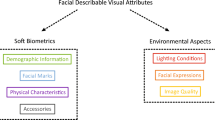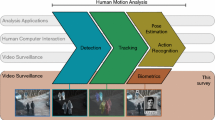Abstract
This chapter addresses the usage of biometric recognition tools in the context of forensic investigations . In particular, the authors are concerned with the extraction of evidence from video sequences captured by surveillance cameras. In such scenarios many of the biometric traits traditionally used for recognition purposes, such as fingerprints, palmprints or iris, are not available. Therefore, the focus is on the extraction of soft biometrics, which encompasses personal characteristics used by humans to recognize or help to recognize an individual. This work starts by reviewing how forensic casework relying on surveillance video information is conducted nowadays. Then, a software platform , BioFoV, is proposed to automate many of the required procedures and including some initial implementation of soft biometric extraction tools. Furthermore, novel biometric methods to analyze human gait and facial traits are described and experimentally validated as a demonstration of future perspectives in soft biometrics.
Access this chapter
Tax calculation will be finalised at checkout
Purchases are for personal use only
Similar content being viewed by others
Notes
- 1.
Microsoft, Redmond, Washington, USA.
References
Ariyanto G, Nixon M (2012) Marionette mass-spring model for 3D gait biometrics. In: Proceedings of the International Conference on Biometrics (ICB), pp 354–359
Baluja S, Rowley H (2007) Boosting sex identification performance. Int J Comput Vision 71:111–119
Baumgart BG (1974) Geometric modeling for computer vision. Stanford University
Biber K (2009) Visual jurisprudence: the dangers of photographic identification evidence. CJM 78:35–37
Bouchrika I, Goffredo M, Carter J, Nixon M (2011) On using gait in forensic biometrics. J Forensic Sci 56(4):882–889
Bouguet J-Y (2011) MATLAB calibration tool. http://www.vision.caltech.edu/bouguetj/calib_doc/. Accessed 26 Mar 2015
Breiman L (2001) Random forests. Mach Learn 45:5–32
Dantcheva A, Velardo C , D’angelo A, Dugelay JL (2011) Bag of soft biometrics for person identification: new trends and challenges. Multimed Tools Appl 51(2):739–777
Fu Y, Guo G, Huang TS (2010) Age synthesis and estimation via faces: a survey. IEEE Trans Pattern Anal Mach Intell (T-PAMI), 32(11):1955–1976
Fu S, He H, Hou Z (2014) Learning race from face: a survey. IEEE Trans Pattern Anal Mach Intell (TPAMI)
Furukawa Y, Ponce J (2010) Accurate, dense and robust multi-view stereopsis, vol 32
Gallagher AC, Chen T (2009) Understanding images of groups of people. In: Proceedings of IEEE CVPR
Guan Y, Li C-T (2013) A robust speed-invariant gait recognition system for walker and runner identification. In: The 6th IAPR international conference on biometrics: IAPR, pp 1–8
Guo G, Mu G, Fu Y, Huang T (2009) Human age estimation using bio-inspired features. In: CVPR’09, pp 112–119
Hadid A, Pietikäinen M, Li SZ (2007) Learning personal specific facial dynamics for face recognition from videos. In: IEEE international workshop on analysis and modeling of faces and gestures (in conjunction with ICCV 2007), pp 1–15
Hadid A, Pietikäinen M (2008) Combining motion and appearance for gender classification from video sequences. In: 19th international conference on pattern recognition (ICPR 2008), p 4
Han H, Jain AK (2014) Age, Gender and Race Estimation from Unconstrained Face Images, MSU Technical report (2014): MSU-CSE-14-5
Harris C, Stephens M (1988) A combined corner and edge detector. In: Alvey vision conference: Manchester, UK, p 50
Hartley R, Zisserman A (2003) Multiple view geometry in computer vision, 2nd edn. Cambridge University Press
Hautamaki S (2011) Forevid: an open source software for forensic video analysis. MSc Thesis, Tampere University of Technology
Horn BKP (1970) Shape from shading: a method for obtaining the shape of a smooth opaque object from one view
Iwama H, Muramatsu D, Makihara Y, Yagi Y (2012) Gait-based person-verification system for forensics. In: 2012 IEEE 5th international conference on biometrics: theory, applications and systems (BTAS), Sept 2012, pp 113–120
Jain A, Dass S, Nandakumar K (2004) Soft biometric traits for personal recognition systems. In: Proceedings of the international conference on biometric authentication, ICBA, LNCS 3072, pp 731–738
Jain A, Russ A (2015) Bridging the gap: from biometrics to forensics. Philos Trans Roy Soc B
Kanade T, Cohn JF, Tian Y (2000) Comprehensive database for facial expression analysis. In: IEEE international conference on automatic face and gesture recognition, pp 46–53
Klare B, Klum S, Klontz J, Taborsky E, Akgul T, Jain AK (2014) Suspect identification based on descriptive facial attributes. In: Proceedings of the international joint conference on biometrics
Klontz JaC, Jain AK (2013) A case study of automated face recognition: the Boston marathon bombings suspects. IEEE Comput 46(11):91–94
Kwon YH, da Vitoria Lobo N (1994) Age classification from facial images. In: CVPR’94, pp 762–767
Lanitis A, Taylor C, Cootes T (2002) Toward automatic simulation of aging effects on face images. TPAMI 24(4):442–455
Larsen PK, Hansen L, Simonsen EB, Lynnerup N (2008) Variability of bodily measures of normally dressed people using PhotoModeler® Pro 5. J Forensic Sci 53:1393–1399
Larsen PK, Lynnerup N, Henriksen M, Alkjær T, Simonsen EB (2010) Gait recognition using joint moments, joint angles, and segment angles. J Forensic Biomech 1:7
Larsen PK, Simonsen EB, Lynnerup N (2008) Gait analysis in forensic medicine. J Forensic Sci 53:1149–1153
Lienhart R, Maydt J (2002) An extended set of haarlike features for rapid object detection. In: Proceedings of the international conference on image processing, Rochester, USA
Lucy D (2005) Introduction to statistics for forensic scientists. Wiley
Makinen E, Raisamo R (2008) An experimental comparison of gender classification methods. Pattern Recogn Lett 29(10):1544–1556
Marr D, Hildreth E (1980) Theory of Edge Detection. Proc Roy Soc B: Biol Sci 207:31
Moghaddam B, Yang M-H (2002) Learning gender with support faces. IEEE Trans Pattern Anal Mach Intell 24(5):707–711
Ng CB, Tay YH, Goi B-M (2012) Recognizing human gender in computer vision: a survey. PRICAI 335–346
Ocean Systems (2015) Ocean systems forensic video and image analysis solutions. http://www.oceansystems.com. Accessed 26 Mar 2015
Ojala T, Pietikäinen M, Mäenpää T (2002) Multiresolution gray-scale and rotation invariant texture classification with local binary patterns. IEEE Trans Pattern Anal Mach Intell 24:971–987
OpenCV (2015) Open source computer vision and machine learning software library. http://www.opencv.org. Accessed 26 Mar 2015
Panis G, Lanitis A (2014) An overview of research activities in facial age estimation using the FG-NET aging database. In: International ECCV workshop on soft biometrics
Qt (2015) Cross-platform application and UI framework. http://www.qt.io/, Accessed 26 Mar 2015
Reid DA, Nixon MS, Stevenage SV (2013) Soft biometrics; human identification using comparative descriptions. IEEE Trans Biom Compend Pattern Anal Mach intell. 36(6)
Ricanek K, Tesafaye T (2006) MORPH: a longitudinal image database of normal adult age-progression. In: Proceedings of FG
Sanderson C, Paliwal KK (2003) Noise compensation in a person verification system using face and multiple speech feature. Pattern Recogn 36(2):293–302
Thornton J, Peterson J (2002) The general assumptions and rationale of forensic identification. In: Modern scientific evidence: the law and science of expert testimony, vol 3. West Publishing Company
Viola P, Jones M (2001) Rapid object detection using a boosted cascade of simple features. In: Proceedings of the 2001 IEEE computer society conference on computer vision and pattern recognition, 2001. CVPR 2001, vol 1, pp I–511–I–518
Will PM, Pennington KS (1971) Grid coding: a preprocessing technique for robot and machine vision. Artif Intell 2:319–329
Xu Z, Schwarte R, Heinol H-G, Buxbaum B, Ringbeck T (1998) Smart pixel: photonic mixer device (PMD); new system concept of a 3D-imaging camera-on-a-chip. In: Eheung EHM (ed) Proceedings: M2VIP ‘98; Nanjing, China, 10–12 Sept 1998, Hong Kong. pp 259–64
Zhang Z (2000) A flexible new technique for camera calibration. IEEE Trans Pattern Anal Mach Intell 22(11):1330–1334
Zhao G, Pietikäinen M (2007) Dynamic texture recognition using local binary patterns with an application to facial expressions. IEEE Trans Pattern Anal Mach Intell 29(6):915–928
Zivkovic Z (2004) Improved adaptive Gaussian mixture model for background subtraction. In: Proceedings of the 17th international conference on pattern recognition, 2004. ICPR 2004, Aug 2004, vol 2, pp 28–31
Author information
Authors and Affiliations
Corresponding author
Editor information
Editors and Affiliations
Rights and permissions
Copyright information
© 2017 Springer International Publishing AG
About this chapter
Cite this chapter
Correia, P.L., Larsen, P.K., Hadid, A., Sandau, M., Almeida, M. (2017). On Using Soft Biometrics in Forensic Investigation. In: Tistarelli, M., Champod, C. (eds) Handbook of Biometrics for Forensic Science. Advances in Computer Vision and Pattern Recognition. Springer, Cham. https://doi.org/10.1007/978-3-319-50673-9_11
Download citation
DOI: https://doi.org/10.1007/978-3-319-50673-9_11
Published:
Publisher Name: Springer, Cham
Print ISBN: 978-3-319-50671-5
Online ISBN: 978-3-319-50673-9
eBook Packages: Computer ScienceComputer Science (R0)




